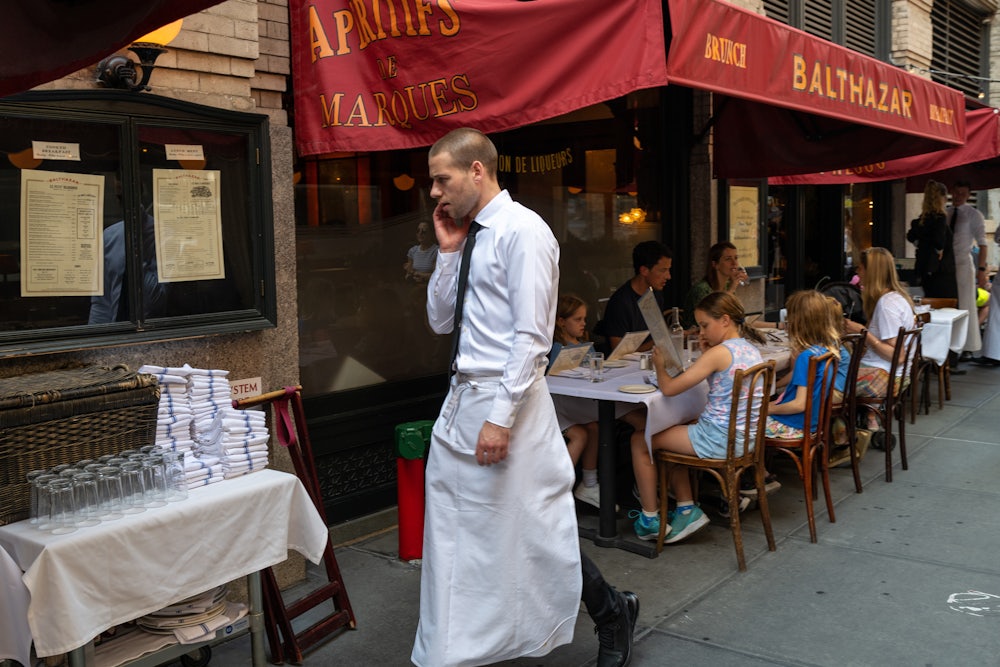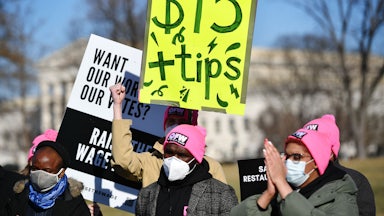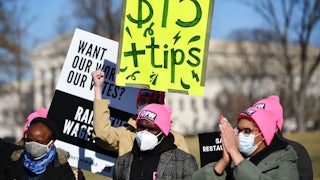We’re at a moment of reckoning in the restaurant industry. Servers are reporting an increase in abuse from diners—just last month, a restaurant employee was beaten unconscious by a group of unhappy customers in Memphis, according to local reports. Restaurants are holding together their finances with duct tape and bubble gum, adding ambiguous fees with labels ranging from “inflation” to “wellness” to help cover rising costs. Consumers are overwhelmed and frustrated by fees, surcharges, and pop-up tip screens where none existed before.
As The New York Times’ Food section entreated last year, the entire industry has become weighed down by one question: “To tip or not to tip?” Compounding the question of whether to leave a little extra behind once the plates are cleared is that few if any customers actually know what these workers are paid in the first place. Many are unaware of the subminimum wage that allows a tipped employee to be paid as little as $2.13 per hour. In New York City, this figure is $10, two-thirds of the minimum wage. That’s $20,800 a year, before taxes.
What wage does your barista make? How about the cashier handing you your takeout? Is your tip a bonus on top of a fair wage—an incentive for good service—or merely a way to transfer responsibility for a fair wage to consumers? In the Fair Labor Standards Act, the U.S. government defines it as the latter, as employers are not required to pay minimum wages as long as customers make up the difference. If you know this, it colors the whole transaction in a different way. Yet we continue to treat tipping as something extra that must be deserved.
Paying for convenience or speed is nothing new. There are fees for express lanes on busy commuter routes; for faster access to rides at amusement parks. These fees are optionally paid by a user who values the additional convenience but are not a part of the fundamental service or product being sold. A mechanic does not expect a tip on a repair, nor does a doctor after your check-up.
Food service employs nearly 12 million people in the United States, or 7.4 percent of the workforce. That’s more workers than are employed in the entire education system, including colleges and universities (6.2 percent), and more than all health care practitioners (5.8 percent). The striking Writers Guild of America writers and SAG-AFTRA actors are just 0.001 percent of the workforce. Restaurant workers have an average weekly income of $458 and an average annual income of $23,815. More than 40 percent of restaurant workers are living with an income that’s less than double the federal poverty line, a common measure for defining low-income households or families that cannot make ends meet. About two-thirds of the tipped restaurant workers in the U.S. are women, and these women are three times more likely than the average U.S. worker to be in poverty.
There is no denying that raising wages will hurt businesses with already narrow profit margins. Many owners claim that they cannot operate while paying a fair wage. They’re telling the truth—pre–Civil War plantation owners had the exact same complaint about the agricultural economy they built. The solution is not to continue allowing a subminimum wage but to build a business model that does not make the exploitation of employees central to its success.
Naturally, I’m not claiming that food service workers are slaves. They are being paid for their labor, just not by their employer. Restaurants offer tipped employees a venue in which to hustle for a buck, but little else. Only 14.4 percent of restaurant workers receive health insurance from their employer. Other benefits are even less common. The bulk of tipped employees’ earnings come directly from customers, in informal and unregulated exchanges that can be extortionate and abusive. So restaurants aren’t enslavers—they’re more like pimps.
And so it shouldn’t be surprising that tipping culture promotes sexism, along with racism and harassment. A 2008 Cornell study showed that diners allow race, gender, and physical attractiveness to affect the amount of their tip. Worse yet, diners of all races consistently tip white servers more than Black ones. In a 2014 survey, 80 percent of respondents experienced sexual harassment in their restaurant workplace, and half had experienced sexual behaviors that were “scary.” Female employees receiving the $2.13 wage experienced twice the sexual harassment of women in states that paid a higher minimum wage. These same women were also three times more likely to have an employer suggest they objectify themselves—dressing sexier, showing more cleavage, or wearing tighter clothing—to increase income in tips. If you want to feel even worse about the routine degradation that women in the industry are subjected to, I recommend you search TikTok for “#pigtailtheory.”
What’s on the line isn’t just a fair wage—it’s an opportunity to provide millions of employees with a safe working environment. Harassment, abuse, and discrimination are commonplace and will continue for as long as uninformed patrons are in control of a server’s base wage.
Danny Meyer made a valiant effort to address this problem when he announced Union Square Hospitality Group’s no-tipping policy in 2015. As he stated in a company newsletter: “The American system of tipping is awkward for all parties involved: restaurant patrons are expected to have the expertise to motivate and properly remunerate service professionals; servers are expected to please up to 1,000 different employers (for most of us, one boss is enough!); and restaurateurs surrender their use of compensation as an appropriate tool to reward merit and promote excellence.… Imagine, if to prompt better service from your shoe salesman, you had to tip on the cost of your shoes, factoring in your perception of his shoe knowledge and the number of trips he took to the stockroom in search of your size. As a customer, isn’t it less complicated that the service he performs is included in the price of your shoes?”
Sadly, Meyer’s desired results did not come to fruition. Few restaurants joined his movement, and many that did later reversed their no-tipping policies. The idea was an ambitious attempt to spark wholesale change, but its ultimate weakness was the inability of consumers to shift their perspective on the perceived price of a meal at the same speed. Not enough people were immediately convinced that a $12 burger was the same as a $10 burger plus tip.
The final nail in the coffin of Meyer’s policy was the pandemic. He said of the reversal: “People did want to tip, a lot, at the beginning, when we could finally come back to eat. It was inhumane to tell our servers, ‘You may not accept that expression of gratitude.’”
In the first two months of the pandemic, this industry lost half its jobs nationwide. Ninety-five percent of restaurant workers lost wages in 2020. One in 10 went to work with Covid symptoms because of economic pressures and inadequate paid sick leave. (Even in states mandating paid sick leave, that pay is only the hourly wage, about 25 percent of average earnings.) Employment levels are still short of the pre-pandemic numbers, and the working environment is worse.
In the post-pandemic market, workers need change like the Raise the Wage Act. If the minimum wage had kept pace with productivity over the past 50 years, it would now be $23 per hour. This act would gradually raise the minimum wage to $17 an hour by 2028. Its implementation would also gradually raise and then eliminate subminimum wages, affording workers the dignity they deserve. It would also allow a tip to truly be a tip.
Restaurant workers have heeded the familiar condescension: “Go get a real job.” It’s time for restaurants to follow the same advice: Build an honest business model where prosperity doesn’t rest on worker exploitation. If your numbers don’t add up, maybe it’s time to for you to consider a different line of work.










